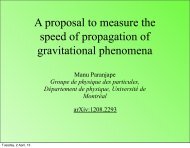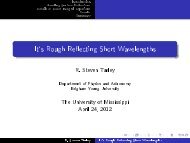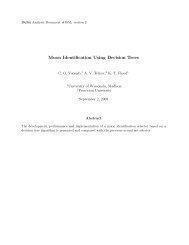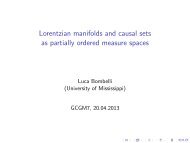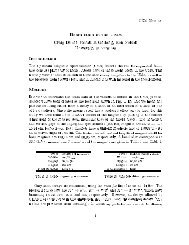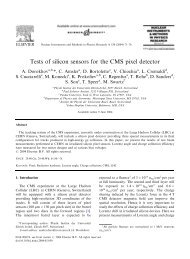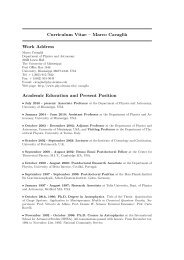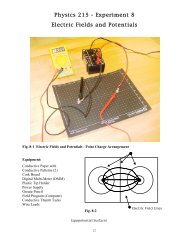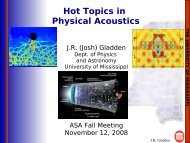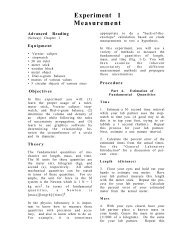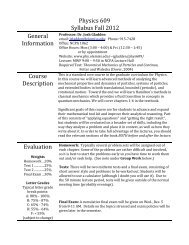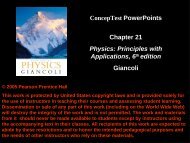Experiment 13 Speed of Sound in Air
Experiment 13 Speed of Sound in Air
Experiment 13 Speed of Sound in Air
Create successful ePaper yourself
Turn your PDF publications into a flip-book with our unique Google optimized e-Paper software.
Advanced<br />
Read<strong>in</strong>g<br />
(Serway) Chapter 18-3, 18-4 and 18-5<br />
Equipment<br />
<strong>Experiment</strong> <strong>13</strong><br />
<strong>Speed</strong> <strong>of</strong> <strong>Sound</strong> <strong>in</strong> <strong>Air</strong><br />
open end<br />
• <strong>Sound</strong> Tube (Fig. <strong>13</strong>-1)<br />
• 3 different frequency tun<strong>in</strong>g forks<br />
• mallet to strike tun<strong>in</strong>g fork<br />
• water jug<br />
• rubber hose<br />
• rubber bands<br />
Objective<br />
L<br />
λ/2<br />
The objective <strong>of</strong> this experiment is to<br />
measure the speed <strong>of</strong> sound <strong>in</strong> air <strong>in</strong> a<br />
tube open at one end and closed at the<br />
other.<br />
Theory<br />
When a sound source <strong>of</strong> some frequency<br />
is placed at the mouth <strong>of</strong> an<br />
open-ended tube, the sound will<br />
travel down the tube, be reflected,<br />
and return to the other end <strong>of</strong> the<br />
tube (Fig. <strong>13</strong>-1). For certa<strong>in</strong> frequencies,<br />
the source will re<strong>in</strong>force<br />
the sound, and a resonant stand<strong>in</strong>g<br />
wave will occur. This allows the ear<br />
to dist<strong>in</strong>ctly hear the sound radiat<strong>in</strong>g<br />
from the tube.<br />
For an open-closed tube, resonance<br />
occurs when an odd-<strong>in</strong>tegral number<br />
<strong>of</strong> quarter-wavelengths fits <strong>in</strong> the<br />
tube (Fig. <strong>13</strong>-3). In order to achieve<br />
the proper conditions for a given<br />
tun<strong>in</strong>g fork, which means a fixed<br />
frequency and wavelength, one must<br />
be able to change the length L <strong>of</strong> the<br />
tube. In this experiment, this will be<br />
accomplished by chang<strong>in</strong>g the level<br />
<strong>of</strong> the water <strong>in</strong> the tube. The difference<br />
<strong>in</strong> water height correspond<strong>in</strong>g<br />
to successive resonances will be λ /2,<br />
so if one knows the frequency <strong>of</strong> the<br />
tun<strong>in</strong>g fork, the speed <strong>of</strong> sound can<br />
be calculated us<strong>in</strong>g the relationship<br />
v =λf , where v is the speed, λ is the<br />
wavelength, and f is the frequency.<br />
water<br />
closed end<br />
Fig. <strong>13</strong>-3 Resonant condition <strong>of</strong> an<br />
open-closed tube <strong>of</strong> length l; a<br />
stand<strong>in</strong>g wave occurs <strong>in</strong> the tube.<br />
Procedure<br />
1. Lift the plastic jug <strong>of</strong> water to a<br />
height so that the sound tube fills<br />
completely with water. Be careful<br />
not to let the tube overflow.<br />
2. Strike a tun<strong>in</strong>g fork with the<br />
rubber mallet and hold it near the<br />
end <strong>of</strong> the plastic tube. Be sure to<br />
hold the tun<strong>in</strong>g fork as shown <strong>in</strong> Fig.<br />
<strong>13</strong>-2. Place the plastic jug on the<br />
floor and listen for resonances as the<br />
water level falls. Slide the rubber<br />
band that is around the tube so that it<br />
is near the position <strong>of</strong> the water<br />
when each resonance are heard.<br />
3. Raise the water jug so that the<br />
water returns to the first resonance<br />
position. F<strong>in</strong>e tune the position by<br />
rais<strong>in</strong>g and lower<strong>in</strong>g the water until<br />
the loudest resonance is heard.<br />
Adjust the rubber band if necessary.<br />
Repeat this process for the other resonance<br />
position.
4. The distance between the two<br />
resonance positions should be λ /2.<br />
Use the frequency pr<strong>in</strong>ted on the<br />
tun<strong>in</strong>g fork and the experimental<br />
value for the wavelength to f<strong>in</strong>d the<br />
speed <strong>of</strong> sound, which is v =λf .<br />
5. Repeat the above procedure for<br />
the other two tun<strong>in</strong>g forks. Calculate<br />
an average value for the speed <strong>of</strong><br />
sound.<br />
6. Calculate the theoretical value<br />
for the speed <strong>of</strong> sound us<strong>in</strong>g the<br />
equation v = (331.5 + 0.61T)m/s, where<br />
T is the temperature <strong>in</strong> degrees<br />
Celsius. Use the thermometer at the<br />
front <strong>of</strong> the room to measure the<br />
temperature. Calculate the percent<br />
difference between your average<br />
value <strong>of</strong> the speed <strong>of</strong> sound and the<br />
theoretical value.<br />
7. There is a table on the board; write your<br />
experimental and theoretical values <strong>in</strong> the<br />
appropriate places. Determ<strong>in</strong>e the class<br />
average for experimental speed <strong>of</strong> sound, v E<br />
and theoretical speed <strong>of</strong> sound, v T<br />
.<br />
Questions/Conclusions<br />
1. Why should the tun<strong>in</strong>g fork be<br />
held <strong>in</strong> the orientation shown <strong>in</strong> Fig.<br />
<strong>13</strong>-2?<br />
2. With the values <strong>of</strong> the speed <strong>of</strong><br />
sound determ<strong>in</strong>ed by all groups, calculate<br />
the mean v, the standard deviation<br />
σ v<br />
, and the standard deviation<br />
<strong>of</strong> the mean σ v<br />
. The f<strong>in</strong>al experimental<br />
value for the speed <strong>of</strong> sound<br />
is v ±σ v<br />
. Does the theoretical value<br />
lie with<strong>in</strong> this <strong>in</strong>terval?<br />
3. If the theoretical value lies outside<br />
the experimental <strong>in</strong> question 2,<br />
what could be responsible for this<br />
systematic deviation?
Figure <strong>13</strong>-1 Figure <strong>13</strong>-2<br />
Apparatus for measur<strong>in</strong>g the<br />
Proper tun<strong>in</strong>g fork orientation.<br />
speed <strong>of</strong> sound <strong>in</strong> air.



